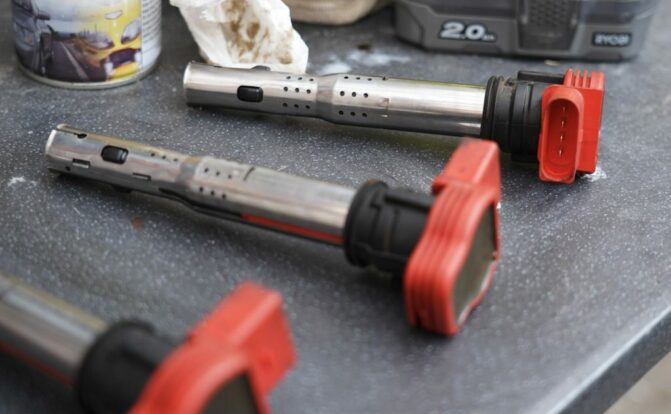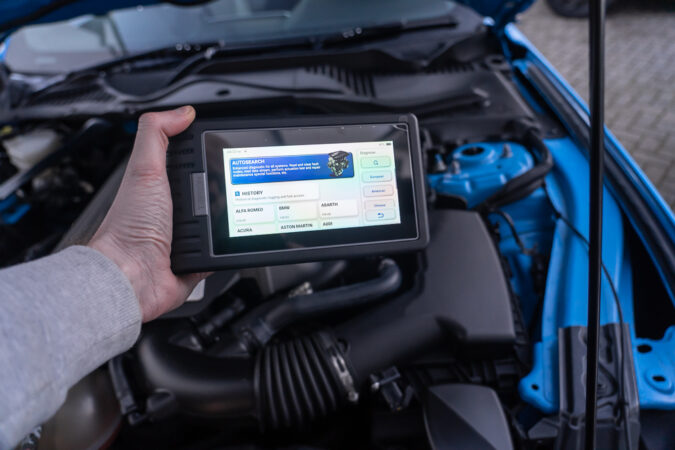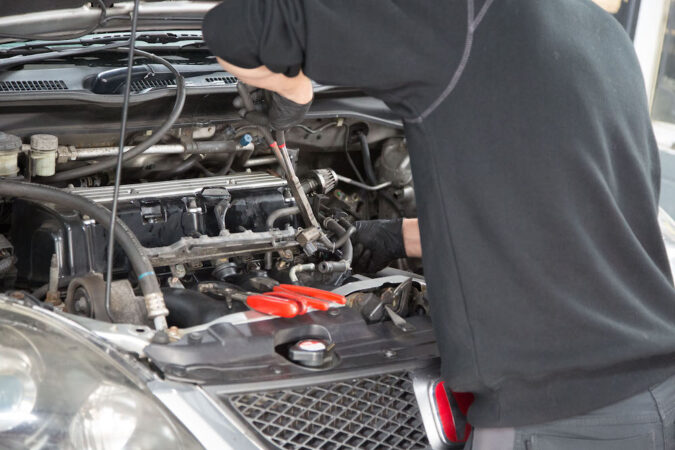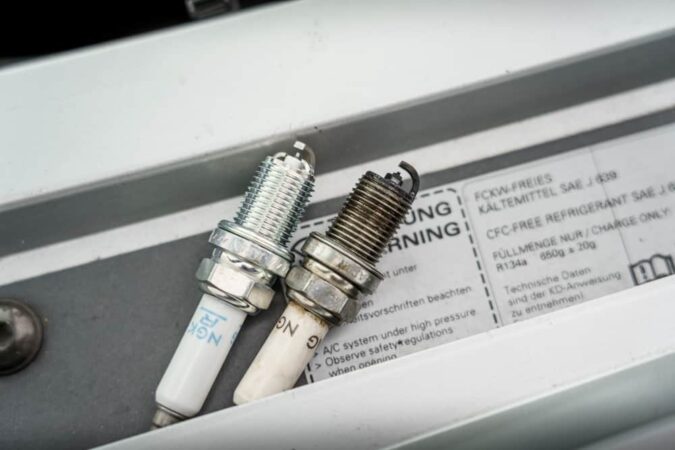The engine is a very complicated puzzle to decode, especially when things go wrong. With a myriad of constituent moving parts and componentry, both mechanical and electronic in nature, diagnosis, and repairs are anything but straightforward. Thankfully, modern cars feature onboard diagnostics and error reporting tools, which makes finding problems much easier… Including a P0302 trouble code.
If you’ve scanned P0302 with an OBDII reader, you’ve probably seen the error message that it spat at you. It’ll say something along the lines of “Cylinder 2 Misfire Detected”. Right away, that’s your issue, there’s a misfire in your 2nd cylinder. Perhaps you’re already familiar with some of its symptoms, like a loss in performance, or backfiring from the exhaust. But what more can you do to fix P0302?
P0302 Code
Before we dive deeper into things, let’s learn more about the definition behind P0302. Or, as we mentioned earlier, “Cylinder 2 Misfire Detected”. Within your engine, there’s one sensor that plays an important role in keeping an eye out for misfires. This particular unit is the crankshaft position sensor. Ordinarily, its job is to monitor and analyze the positioning and rotational speed of the crankshaft.
In doing so, it’s able to inadvertently detect when a misfire occurs. The “crank sensor” does it by sensing minute variations and pulses in the rotational speed of the crank. Which, otherwise, a misfire would alter slightly. The crankshaft sensor notes it down as a misfire and passes it on to the ECU (or engine control unit). Your ECU will then illuminate a check engine light, and throw a P0302 code.
In short, that’s what a P0302 error code means, a misfire has been found. Now, misfires could happen in one, multiple, or perhaps every single cylinder inside your engine. With a P0302 code, this tells you that Cylinder #2 is misfiring. For example, if you’re seeing a P0301 code, this means that a misfire is found in Cylinder #1. Or, in Cylinder #6 if you’re seeing a P0306 code pop up and etcetera.
But how can you find and discern which of your cylinders is #2? Unfortunately, this is something that you’ll have to learn by pouring over your car’s owners or service manual. For example, let’s say your car has a Ford V8. Typically, cylinders 1, 2, 3, and 4 are found on the passenger side of the bank. But if you have an inline-4 engine, it usually starts with 1, 2, 3, and then 4, starting from the timing belt.
P0302 Cylinder 2 Misfire Detected
If you’re not used to car-related mechanics, you might be wondering as to what a ‘misfire’ is. Well, an engine misfire is a circumstance where there’s incomplete combustion inside the engine. It may be impacting the combustion process in just one cylinder. Or, in more serious cases, it may affect several or every single cylinder, all at once. In other words, the cylinder(s) isn’t firing (or igniting) properly.
Remember that an engine requires four key components for combustion to occur. It requires air and fuel, as the primary sources of power. Next, you’ll need compression (which is created by your pistons moving up and down from the previous combustion cycle) to pressurize and concentrate the mixture. Last but not least, you’ll need a spark (from the spark plugs) to ignite the air-and-fuel concoction.
With all these combined, you have one completed combustion cycle, before it continually repeats. But what if any one of those items (air, fuel, compression, or spark) isn’t present? In that case, it’ll impact the ability of the engine (particularly, on a cylinder-by-cylinder basis) to combust. When it’s unable or refusing to combust, you have what’s called a ‘misfire’. Typically, a misfire is only momentary.
You’ll experience that sputtering, coughing, and sluggishness from your engine as the misfires occur. Under normal circumstances, a misfire would clear itself after a few seconds, and it’ll then proceed to combust properly. Nevertheless, just one misfire is indicative of possible issues with your engine. It’s a good idea to have that misfire looked into before it materializes into other problems down the line.
What Are The Different Types Of Misfires?
Besides understanding what a misfire is, it might be handy to learn that there’s not just a single type of misfire. Instead, there are three common types of misfires. For the most part, these three types of misfires could better inform you as to what’s causing them to appear. These should help you narrow down the root cause of why you’re seeing that P0302 misfire. These misfires are:
- Spark Misfire – This type of misfiring, as the name suggests, points you towards there being issues on the side of the spark plug. Most likely, one or more spark plugs aren’t firing (or, ‘sparking’), which will thus cause incomplete combustion (or a misfire) to happen. Spark misfires are the most common, and that’s a good thing because spark plug replacements are both cheap to buy and simple to perform (once you learn how to replace the spark plugs, and learn how many spark plugs in a V8).
- Fuel Misfire – Now, this one’s a bit more complicated than spark misfires, as it naturally involves your car’s fuelling system. It could be that your fuel filter is clogged, hence preventing the right amount of fuel from entering the combustion chamber. Or, the fuel injectors are dirty and aren’t supplying the engine with the right amount of fuel, either. Without sufficient fuel, your engine can’t combust.
- Mechanical Misfire – Lastly, mechanical misfires are the most headache-inducing. Not to mention, it’s highly damaging if not fixed promptly. ‘Mechanical’ can be defined as the timing chain or belt having slipped and isn’t synching up the combustion timing. Alternatively, the valvetrain that manages the flow of air and fuel into and out of the engine isn’t opening and closing properly, among many others.
What Causes A P0302 Error Code To Appear?
But why are you seeing a P0302 error code and are experiencing a misfire, in the first place? Here are some of the most common causes of P0302 misfires (Cylinder #2):
- Bad or worn-out spark plugs, or faulty spark plug wiring that can’t reliably supply electricity.
- Problems within the ignition system, or faults with the ignition wiring, sensors, and modules.
- The (ignition) coil pack isn’t inducing a high enough voltage for the spark plugs to ignite.
- Clogs, blockage, or leakage within the fuelling system, causing a drop in fuel pressure.
- Using bad or contaminated fuel, as it’s now becoming harder to ignite it (as is the case when you put gas in a diesel engine).
- Driving with a low or empty gas tank, as the engine doesn’t have enough fuel to burn.
- Bad ignition timing, which isn’t igniting the air-and-fuel mixture at optimal efficiency.
- Faulty mass airflow (MAF) sensor, which may not be measuring airflow into the engine correctly.
- Broken throttle position sensor, which is unable to properly monitor the air intake.
- Low engine compression, as it’s unable to thoroughly pressurize the air and fuel mixture.
- Exhaust gas recirculation (EGR) problems, such as clogging or leaks near the EGR valves.
- Evaporative emissions system (EVAP) issues, like fuel vapors leaking away from the engine.
- Visible damage or cracks on the distributor cap (applicable if you have an older car).
- Faulty camshaft position sensor or crankshaft position sensor, failing to read the engine properly.
- Damaged valvetrain, as it’s unable to correctly allow air and fuel into and out of the engine.
- Vacuum leaks, as air bypasses the engine entirely instead of going into the combustion chamber.
- Clogging in the catalytic converters, which causes the engine to overheat and misfire as a result.
- Glitchy ECU programming, which is unable to manage the engine’s operation (albeit this is rare).
What Are The Symptoms Of A P0302 Misfire?
When a P0302 misfire does occur, the symptoms should be immediately apparent. Some of the most common symptoms accompanying misfires include:
- Acceleration is rough and jerky, as there are significantly more vibrations and shakiness while you’re on the throttle. It’s usually noticed at higher gears and low RPMs when the engine is under heavy load.
- Idling is rough, and you’ll also feel the vibrations and shaking reverberate in a more pronounced way compared to before. Your engine is most sensitive towards combustion issues while it’s idling.
- Engine stalling, as there’s a higher risk of that during a misfire than otherwise. Although, stalling is a sign that your misfires have gotten worse. Generally, the stalling is most frequent while idling. If the misfire manifests early on, you might also find it hard for the engine to turn over and start up.
- Illuminated check engine light, which is to be expected if you’re seeing a P0302 code. That light is the engine’s way of alerting you to a potential problem. And, that it’s stored an error code for analysis in its memory. You can then plug in an OBDII diagnostics tool to download these trouble codes.
- Sluggish performance, more prominently while accelerating or when you’re going at higher speeds. It can impact your engine’s potency, or in some cases, force your car into a reduced ‘limp home’ mode. You’ll feel it as hesitancy during acceleration, or the engine taking more time to power up.
- Gruff sounds from the engine and exhaust, which is less refined than usual. That change in pitch and tone occurs as one or more cylinders aren’t firing. You can hear how only some cylinders are firing. If you have an inline-4 engine, it might sound like a 3-cylinder now that Cylinder #2 isn’t combusting.
How Can You Diagnose A P0302 Misfire?
Given that a wide variety of problems could’ve caused a P0302 misfire to take place, how can you try to narrow down the point of failure? In diagnosing a P0302 error code, you’ll be better informed and have the right knowledge of what caused it, before undertaking any repairs down the line. Your first step would be to use the OBDII diagnostics tool and clear out any error codes, including P0302.
Then, take your car out for a brief test drive, and see if the misfires or P0302 error code reappears. It helps to ensure that you don’t have a false positive before proceeding with any further diagnosis and troubleshooting. Furthermore, you could also scan for any other error codes, and try to resolve those ones before coming back to P0302. Fixing those other error codes may help to get rid of the misfire.
Once you’ve done these, you can begin a diagnosis of your engine’s Cylinder #2 misfire (P0302) by:
Step 1: Conduct A Visual Inspection
For starters, let’s visually inspect the affected components to see if we can find visible signs of faults or clues as to what’s wrong. Begin by inspecting the spark plugs, spark plug wires, ignition coil, and the wires, connectors, and cables that lead to and from these ignition-related components.
It might be that these wires have been frayed, are damaged, or have loose connections. In particular, try to focus more on Cylinder #2’s spark plugs and ignition systems. Remove the #2 spark plug, and see if you can spot a large gap, fouling on the tips, arcing, and other forms of damage.
You may consider taking a peek at your car’s service history, and see when’s the last time your spark plugs were changed. If it’s been a while since then, then it’s a good idea to undertake any repairs or replacements of the spark plugs, spark plug wires, ignition coil pack, and coil pack wiring.
Step 2: Confirm That The #2 Spark Plug Is Firing
Once you’ve gone through with a visual inspection, you can try to confirm that the #2 spark plug can’t fire properly. There are two ways that you can do this. The first method involves getting a spark plug tester, to verify whether or not a spark (and one that’s sufficiently strong) is present at Cylinder #2.
Your alternative technique revolves around swapping the spark plugs. Try swapping the spark plug on Cylinder #2 with spark plugs from adjacent cylinders (let’s use #3 as an example). If Cylinder #2 is now firing properly, but Cylinder #3 isn’t, then you’ve confirmed that the #2 spark plug is bad or worn-out.
Step 3: Make Sure The Fuel Injector Is Working Right
Steps 1 and 2 were a test of the ignition and sparking systems of our car. If no faults have been found there so far, you can try Step 3. This time around, we’ll be looking at the fuelling system, starting with the fuel injectors. To begin, keep your OBD scanner plugged in, and the ignition key turned to “ON”.
With the ignition in its ON state, you can now begin monitoring the fuel pressure and flow through an OBD diagnostics tool. In particular, look at the fuel pressure as each injector is working. There should be a drop in pressure by the fuel rail when it does so. Otherwise, it might point to a clog in the unit.
For older cars that feature distributors, you can begin by inspecting the distributor caps as well as the rotor button. See if there’s any sign of cracking, corrosion, wear and tear, or any other damage. With an OBDII scanner, you may as well continue monitoring the fuel pump, and the rest of the system.
Step 4: Check The Engine’s Compression Rate
The last step in diagnosing a P0302 misfire is conducting a compression test. This isn’t usually done, as misfires are often attributed to sparking or fuel-related issues. Those two should’ve been found and resolved by the first 3 steps. If you’re still experiencing a misfire, a compression test is necessary.
It’s best that you leave this for the professionals, as you’ll need a specialized compression tester for a test to be conducted. Typically, compression tests are done for each cylinder, before comparing them to see if Cylinder #2’s compression isn’t in line. Include a margin of error of around 10% to 15%.
How Can You Repair And Fix A P0302 Misfire?
Given the wide scope of potential failure points that caused a P0302 misfire to occur in the first place, it means that fixes will be quite varied, too. For the most part, failed parts that caused a misfire can’t be repaired. Rather, a full replacement is necessary. However, certain components could instead be reconditioned. For instance, you could easily clear out clogs and debris in the fuel injectors.
All you need is a bottle of fuel injector cleaner, instead of replacing the injectors altogether. With that being said, most other parts involved in misfires will require swapping for brand new ones. Here’s a brief rundown of what to expect price-wise, including both the cost of parts and labor:
| Component | Replacement Cost |
|---|---|
| Spark Plugs | $50 to $250 |
| Ignition Coils | $250 to $650 |
| Spark Plug Wires | $150 to $250 |
| Ignition Coil Wires | $100 to $300 |
| Fuel Injectors | $1,500 to $2,000 |
| Vacuum Leaks | $100 to $200 |
| Fuel Pump | $1,300 to $1,700 |
| Fuel Pressure Regulator | $200 to $400 |
| MAF Sensor | $100 to $500 |
| EGR Valve | $150 to $550 |
| Crankshaft Position Sensor | $150 to $250 |
| Camshaft Position Sensor | $100 to $200 |
| Throttle Position Sensor | $150 to $200 |
Final Thoughts On A P0302 Error Code
That then rounds up our look at a P0302 error code and the Cylinder #2 misfires that it’s signaling. In short, the wonders of modern automotive onboard diagnostics have made it much easier to find and diagnose, as well as repair problems quickly. This includes misfires, which are usually among the hard ones to pinpoint and narrow down, owing to how many components could’ve caused it to appear.
If you have a Cylinder #2 misfire, it’s wise to have it looked into and resolved as soon as possible. If it’s left as-is and you keep on driving with a misfiring engine, it can cause significantly more issues down the line. Misfires put a lot of wear and strain on the engine, which could lead to expensive as well as complicated fixes. It’s better to spend hundreds now before you’re cashing out thousands later on.
Frequently Asked Questions On A P0302 Error Code
Here are some of the most popular FAQs on P0302 error codes…
How Do I Fix Code P0302
If you’re experiencing a P0302 misfire, either you or a mechanic will have to perform thorough check-ups and diagnoses. This is all done to see what components have failed and caused those misfires to occur. The most common cause of a P0302 misfire is related to the spark plugs. In that case, all you’ll have to be worried about is replacing the spark plugs, which is relatively inexpensive.
Can I Drive With A P0302 Code
In theory, and depending on how bad the symptoms are, you could still drive with a misfiring engine. Although, it shouldn’t be done for too long, so use this opportunity to drive to the nearest workshop. Keep driving as if nothing happened, and that misfire could cause serious issues to crop up as a result. It may lead to the catalytic converter wearing out, or prompt internal damage inside the engine.
P0302 Ford
Some of the most popular Ford models could be seen with a P0302 misfire error code. This includes its iconic F-150 pickup truck, alongside the Fusion, Ranger, Mustang, Everest, and more. Commonly, this P0302 error code on Fords is linked to rusty connector pins on the spark plug and ignition coil wires. In addition, see if there are any intake (vacuum) leaks, and reprogram the entire ECU if necessary.
P0302 Honda
No matter if you have a Civic, an Accord, or any other Honda model, you’ll find P0302 error codes on their cars, too. The most common point of failure, as with most other vehicles, is the spark plugs. In particular, and related to Honda’s oil dilution issues, the oil may stick onto the spark plugs. Additionally, the valve cover gaskets should be inspected, just to make sure it’s not leaking any engine oil.
P0302 Toyota
A quick Google search suggests that the Corolla suffers P0302 error codes more so than other Toyota models. In any case, it’s been noted that the ignition coils are the primary culprit for misfiring engines in the Corolla, not spark plugs. Diagnosing them should be relatively easy. Just swap out the coil pack from Cylinder #2 to a different cylinder, and see if the misfires are repeated on that other cylinder.
P0302 Chevy
If you have a Chevy, a P0302 misfire might first trigger the “Service StabiliTrak” warning message. It usually is related to traction and stability control. However, seeing that it’s tied to the engine, it can detect misfires, as well. Once again, misfires in a Chevy, especially with the StabiliTrak light, can be faulted to the spark plugs. Or, wiring around the spark plugs and ignition coils that have gone bad.




